There are a few cookbooks that I have on my shelf that I find myself coming back to time and time again. The last few days, I've enjoyed browsing and re-reading sections in three such books, namely Jane Grigson's classic «Charcuterie and French pork cookery» and Fergus Henderson's more recent cult classics «Nose to tail eating» and «Beyond nose to tail».
These books have a few things in common: They're mostly, and in Grigson's case exclusively, dealing with pork. And I love pork. Every thing about it. Apart from a common love of pork, they also have that in common that their recipes are rather vague, oftentimes omitting measures and timings altogether. In a day where most recipes are measured with exactness down to the gram and braising times are given in minutes (rather than the more sensible «cook until the meat tender»), this feels extremely refreshing. They both use simple and cheap ingredients and cuts of meat, but manage to take an otherwise bland cut to another level by a deep respect for even the humblest of ingredients on hand.
Finally, both Grigson and Henderson convey a wonderful British sense of humour in their books. Henderson, for instance, compares shelled walnuts rolled up in salted fatback with «eating grown-up peanut butter». In his recipe for «duck legs and carrots», Henderson instructs to «press the duck's legs into the carrot bed, skin side upwards, season the dish and pour chicken stock over until the duck's legs are showing like alligators in a swamp». In her book, Grigson often paints a slightly negative picture of the food and ingredients available in her native England compared to the wonderful abundance found in France. I'm sure things have improved in England since she wrote her original text back in 1966, but it's her vivid and delightful descriptions of French preparations that gets me every time. Her book shares many similarities to those of Elizabeth David, I think, and her style probably owes quite a bit to that of David. In her description of Pieds de Porc à la Sainte-Ménéhould, pig trotters prepared in the Sainte-Ménéhould manner, Grigson writes «spiced with quatre-épices and rolled, like pieds panés, in breadcrumbs, they have been cooked for so long – 48 hours – that they can be eaten bones and all. This gives three textures – crisp, gelatinous and the hard-soft biscuit of the edible bones. ... One charcutière told me that it's the addition of a certain vegetable or herb that causes the bones to soften, as well as the prolonged slow cooking. Local sceptics tartly hint at 'produits chimiques'.»
In this day and age, I feel very lucky to live close to two first class butchers, that gladly take orders for more unusual cuts. Inspired by the two cookbook authors, I placed an order for a pig's head, some ears and a handful of trotters. The plan? Grigson's Fromage de Tête and Henderson's Trotter gear. The ears I were not sure of what to do with.
Both Henderson and Grigson advocate the use of a strong brine to pickle meat. Salting of most pork cuts greatly improves flavour, but a brine can be used for some limited storing of the meat as well. Time spent in the brine can vary from a day up to weeks – depending on the cut and dish that is to be prepared. Prior to collecting my order, I had cooked and cooled 12 liters of a classic English brine, after Henderson's proportions (150 gr salt and 100 gr sugar per 1 liter water – bring to a boil, then add a piece of tied muslin with peppercorns, juniper berries, cloves and herbs and leave to cool completely). In went the head, which was luckily divided in two equal halves, the ears and trotters. Below is the bucket used for the head and some trotters, the remaining bits and pieces went into a smaller bucket. It just fit into the fridge... 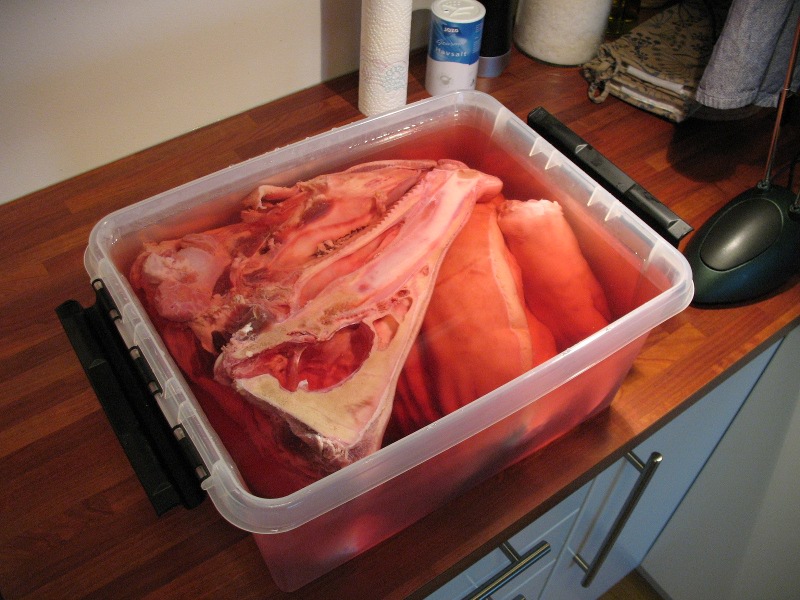
After pickling for 48 hours, I was all set to get things underway, heads and all. 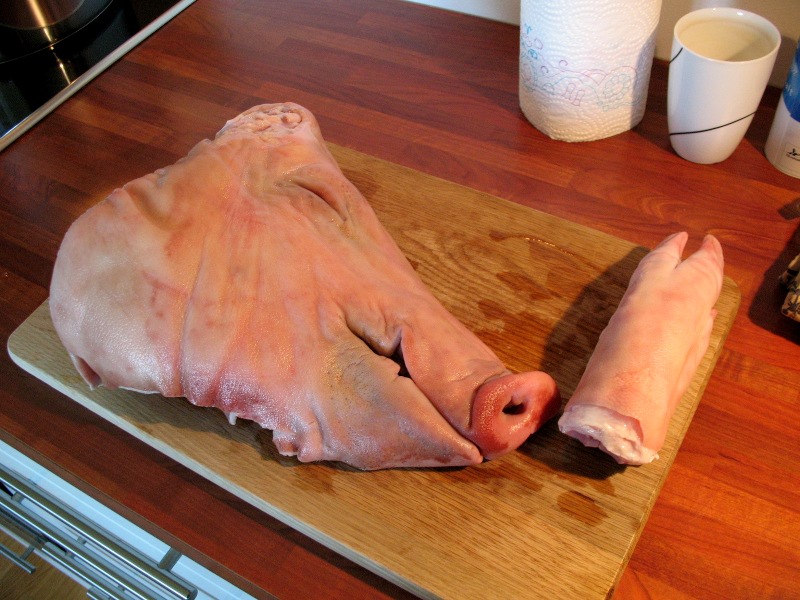
It looks happy – I trust it had a happy and carefree time. I hauled out my largest casserole, and placed the two head halves and three trotters in it. Filled up with water, and brought slowly to a boil to flush skum and excess salt away from the meat. 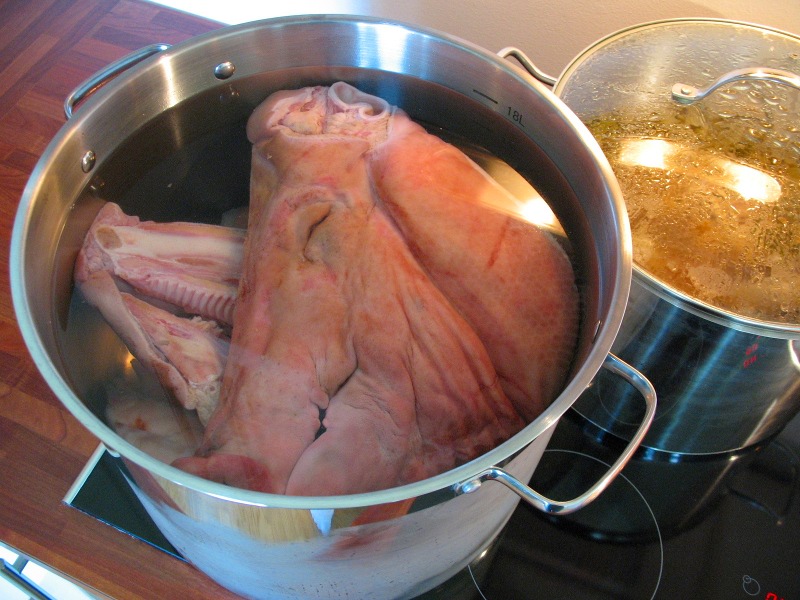
Throw out the filty and salty water, clean the meat and the casserole, and put everything back along with plenty of stock vegetables and top up with water. Cook up again, and leave to simmer until the meat is tender, anything from 4 to 8 hours.
Now, while this is simmering away, I had ample opportunity to take care of the remaining trotters for the trotter gear. 
The strategy is very similar – just get your court-bouillon going with whatever it is that needs to be cooked tender. These trotters were simmered in some of the duck stock from last weekend, so I guess this is the trotter gear royale version. I could in principle have cooked them in the pot for the Fromage de Tête, as there was room enough for it all in there, but I feared that too many trotters in there would bring about too much gelatine and cause the stock to become hard as rubber once cold; a nice Fromage de Tête is characterised by meat suspended in a firm, but giving, jelly. It should not be rubbery hard, but rather instantly melt on your tongue when you eat it. Thus, three trotters went into the pot with the head, and (I'm jumping a bit ahead here) this resulted in a perfectly set and giving jelly.
I threw a couple of ears in with the trotters for the trotter gear – the ears are done after roughly an hour, so they were fished out of the pot, flattened, sliced in two lengthwise, rolled in butter and lightly toasted breadcrumbs, pan-fried and enjoyed with a blue cheese salad with a lemon-walnut vinaigrette (i.e. a take on the Oreilles de Porc Grilées Sainte-Ménéhould - to further emphasise the poshness, the breadcrumbs were pain au levain breadcrumbs. Enough already).

I've had pig's ears on occasion before, and I'm usually more enthused about the contrasting textures in the ear than the flavour itself. The cartilage that runs down the center of each piece is a chewy contrast to the soft and giving flesh on either side. Oh, and pan-fried pig's ears is a perfect dish to make just before you're going to wash and scrub down your kitchen. It spatters and spits like you wouldn't believe, so that makes perfect sense.
By now, the trotters are just about finished, and ready for potting: 
My fridge is now, as Henderson advises, no longer «without its jar of Trotter Gear». Just got to figure out what to do with the lipsticky goodness next...
It turned out to be a marathon day in the kitchen, but one that was hugely rewarding and rich in taste, smell and fatty pieces of pork (which I love). By now, the pot with the ingredients for my Fromage de Tête had simmered close to 5 hours, and the jaw loosened easily from the head itself. A sure sign of doneness according to Grigson. Using the sturdiest piece of kitchen utensils I own, I somehow managed to wrangle all the meat out of the scorching hot simmering liquid without making a mess or getting second-degree burns. *phew* 
It's heavy! The whole head weighed in at roughly 8 kg, but both halves made it out of the pot okay. Now's when the real work starts: Tearing all the flesh from the skull while it's still hot (easier to do so then, compared to when it's cold), chopping it into fine dice, and adding a healthy glass of white wine to about a litre of the cooking liquor. This is reduced slightly to make sure it sets up properly once cold, and mixed with some lemon juice to help cut the fatty flavour of the meat. Most of the meat from the head comes from the two tasty pork cheeks, but there are also interesting bits from the snout – not all that dissimilar to the slightly spongy mouthfeel feel of a boiled tongue. Quite delicious. Season with some pepper and crushed cloves (or quatre-épices if you get it – in either case, go easy on it), and spoon into loaf pans lined with cling film: 
Pour in enough of the reduced cooking liquor so that all the meat is covered, slam the loaf pans a few times against the kitchen table to make sure everything is well packed in, cover the surface and refrigerator overnight. I anxiously pulled the fromage from the fridge the next morning, carefully unmoulding it from the loaf pan... Would it collapse in a puddle or would it hold its shape and be sliceable? 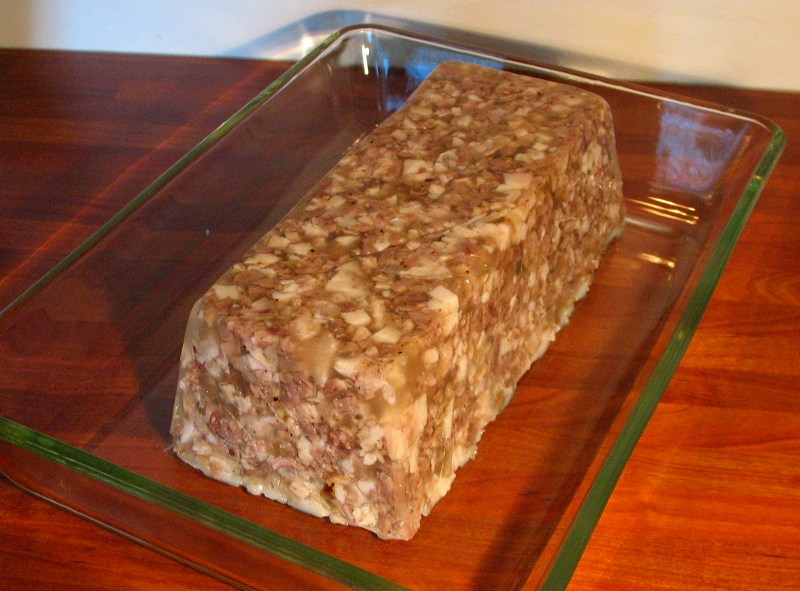
Victory! This is my first attempt at this dish, so I'm not sure if it stacks up with the rest of them – I'm most uncertain about the dice; too fine? I was afraid that a larger dice would cause the fromage to collapse upon cutting, so I kept it on the small side. Size of dice apart, it is truly utterly delicious and one of the more rewarding dishes I've cooked up.
So, what to have with a cold slice of unctuous goodness that just melts on your tongue? Grigson recommends: "French mustard (to my mind essential with most pork dishes, particularly the smooth, gelatinous ones), hardboiled eggs, green salad dressed with 2 tablespoons of raw chopped mild onion and 2 tablespoons of chopped parsley as well as oil and vinegar and seasonings. Mashed potato is a standard accompaniment to charcuterie - slimmers might prefer thin toast, or wholemeal or rye bread." To be honest, I find the brawn plenty rich enough as is, so I didn't exactly jump on the idea of having this with a pommes purée. Mustard and rye it was for me, all the way.
A celebratory meal was prepared with the fresh brawn: Accompanied with a loaf of rye sourdough, French mustard and a nice brew. A simple meal I enjoyed almost as much as preparing it. 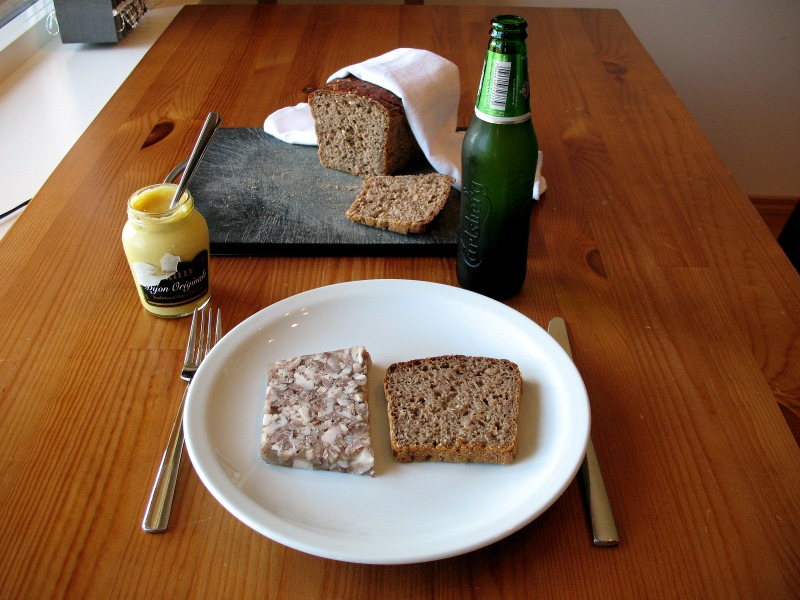
PS: The rye sourdough was a slight modification of Hamelman's 80% rye sourdough with a rye flour soaker – I simply omitted the yeast, added some boiled rye berries and increased the hydration to about 90%. The perfect vehicle for the brawn.